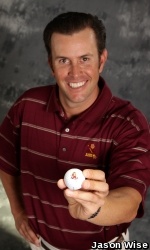From “Huff’s Stuff” Arizona Golf Blog by Bill Huffman at the Arizona Golf Authority
 Brad Williams has been on the job for just a few months as the new general manager and director of golf at the TPC Scottsdale.
Brad Williams has been on the job for just a few months as the new general manager and director of golf at the TPC Scottsdale.
For the most part, the former boss at the TPC Boston has been low profile since he assumed the reins from Bill Grove, who retired following the 2013 Waste Management Phoenix Open.
I finally caught up with the easygoing Williams last week, and during our conversation I asked him about his early experiences on his new job.
“Oh, it’s been great. I’m loving it,” said Williams, who once was the head pro at the TPC Scottsdale (2000-2002). “In fact, it’s been near-perfect with the exception of that story in Monday’s paper.”
“That story” Williams was referring to ran in the Arizona Republic under the headline: “Critics question Scottsdale’s spending on TPC.”
In the article, the Republic detailed how the Scottsdale City Council planned to pay for a $15 million renovation of the TPC’s Stadium Course rather than the renovation being the responsibility of the PGA Tour, which hosts the Waste Management Phoenix Open on that course annually. It also pointed out how the City of Scottsdale has paid fees totaling almost $26 million to keep the TPC Scottsdale running since it opened in 1987.
But what probably riled Williams, at least a little bit, was the part about how the $15 million deal that also involves updating the TPC’s clubhouse had been met with criticism from “a loosely organized group of Scottsdale residents concerned about municipal spending.” And it also mentioned how those critics were threatening possible legal action if the City Council didn’t reconsider and get a better deal from the Tour.
Oh, yes, and in exchange for that $15 million renovation, the newspaper reported, the Tour will increase its fees paid to the course over the next 20 years by a mere $4 million, as well as extend the contract for the Waste Management Phoenix Open by six years through 2022. There were other details about the project, which doesn’t include the TPC’s lesser known Champions Course, but those were the big ones.
Being a skeptical sort, I also questioned whether the TPC Scottsdale really needs a $15 million facelift. Seriously, for $15 mill you would think that you could blow up the Tom Weiskopf-Jay Morrish design and build an entirely new one, although you might not have quite enough dough for the course and the clubhouse, too.
But after talking with Williams and the guy who ram-rodded the deal through the Scottsdale City Council, Mayor Jim Lane, I think everybody in Scottsdale should just chill on this subject and let it happen. It’s all good for Scottsdale and the entire Valley, especially the $90 million a year economic impact punch the tournament provides, and here’s why:
Contrary to what many are assuming, Lane told me, the project is not being funded by the city’s taxpayers. Instead it’s a combination of the monies received from the city’s hotel bed tax, as well as that aforementioned $4 million from the Tour.
“We felt like we worked a very hard but fair deal with the Tour,” Lane said. “And (the renovation is) going to happen regardless (of what some might say).”
According to the Republic article, an attorney representing opponents of the deal has urged Lane and the City Council to renegotiate more favorable terms. The article also cited Mark Stuart, a financial analyst and leading opponent of the TPC deal, who claimed that the most well attended tournament in professional golf has no real direct benefits to Scottsdale, and threatened legal action if the city goes through with the project.
“That’s strictly nonsense,” said Lane of the crowds at the TPC that often swell to over 500,000 fans for the week, and the worldwide TV coverage that showcases Scottsdale’s beautiful weather during a period when most of the country is caught in winter’s woes.
“People can threaten whatever they want, but we’re very comfortable with what we’re doing in financing this project.”
So why do we need to renovate the Stadium Course at the TPC Scottsdale, the one that gets the highest green fee in Arizona (approximately $300 in peak season)? Lane and Williams have slightly different perspectives on this project, which again will be spearheaded by Weiskopf, but both are pertinent.
“First and foremost, this is a golf course that has been owned by the City of Scottsdale for almost 30 years, and so it’s our golf course we’re funding,” Lane said. “Scottsdale is all about golf. It’s how we portray ourselves to the world.
“In the bigger picture, it also represents the entire Valley. So we want it to look good for not only Scottsdale, but all of Arizona.”
Adding to that, Lane said the 7,218-yard, par-71 layout needs to be “more challenging.” But Williams said that, from the Tour’s perspective, “We don’t think our goal is to make the TPC more difficult but rather to modernize it for today’s game.”
“Golf fans still want to see birdies and see players play well, so we don’t want to change that,” he added. “This will bring it into the 21st Century.”
Williams said that among the changes that will occur from April 1 to mid-November, 2014, when the course will be shut down for the renovation, are the following:
*The greens will be completely stripped down 4 to 5 inches in depth, new materials added, and grown back in with “a few subtle changes.” A few holes, like Nos. 2, 3 and 4, might end up in new locations.
*Restructure the tee complexes, which could add or subtract length.
*Rebuild and reshape bunker complexes, while strategically removing some and adding others. All will have new sand.
*Renew cart paths and reposition desert landscape, although Williams promised the “Tiger Rock” from the 1999 Phoenix Open is to remain status quo. “Wouldn’t dream of removing that,” he said with a laugh.
*Update the irrigation system and plant.
*Remodel the clubhouse, adding new locker space and a new indoor dining room for the players and their families, as well as redoing the TPC Grille.
“It doesn’t sound like a big deal, but basically we want to enhance the players’ experience while maintaining the tournament’s image as one of the best on Tour,” Williams said.
This will be Williams’ first time handling a project of this magnitude, although he does have some experience in the area of remodeling a facility while he was at the TPC Boston.
“But this is my biggest project, and I’m really excited,” he said. “I’m confident that we can get this done on time, because one of the good things about it is we’ve been in the planning stages for some time. We’ve really thought it through.”
Evidently others are getting on board. This week the Republic endorsed the project in an editorial entitled: “Phoenix Open Funding Wise,” stating that a “renewed commitment is of vital importance for this city.” The op-ed page even took a shot at the critics, calling their claims “unfounded and utterly ludicrous.”
Although the editorial never mentioned it, I’ll give you one more reason why this $15 million renovation is more than justified: It keeps the lifeline of precious charity contributions generated by the Waste Management Phoenix Open flowing throughout the Valley.
Indeed, the Phoenix Open never has gotten the recognition it deserves for its philanthropic ways. But every year the Thunderbirds, the civic group that runs the Waste Management Phoenix Open, raises $4 million or $5 million or $6 million for charity – or over $52 million in the last 10 years alone.
That sum raised by the Waste Management Phoenix Open is more than the Arizona Cardinals, Phoenix Suns, Arizona Diamondbacks and Phoenix Coyotes have raised combined. And just think of all the taxpayer money that has been spent on those professional sports over the years!
Certainly the completion of the renovation is something to look forward to when the TPC Scottsdale’s Stadium Course opens anew in 2015, Williams added.
“It’s the year we’ll unveil the golf course, and the Super Bowl returns to the Valley, “ he said. “Should be a very exciting time around here.”
Yes, Brad Williams has been on the job for just a few months, but he seems to be fitting in just fine.
Click “Huff’s Stuff” Arizona Golf Blog for all of Bill Huffman’s articles.
Visit the Arizona Golf Authority’s Arizona Golf Course Reviews for an “Insider’s Playing Review” of every golf course in Arizona.
 PEORIA, Arizona. – Quintero Golf Club General Manager Tom Wilcox announced today that Quintero’s popular Q-Card is back for 2013 and on sale now.
PEORIA, Arizona. – Quintero Golf Club General Manager Tom Wilcox announced today that Quintero’s popular Q-Card is back for 2013 and on sale now.


















